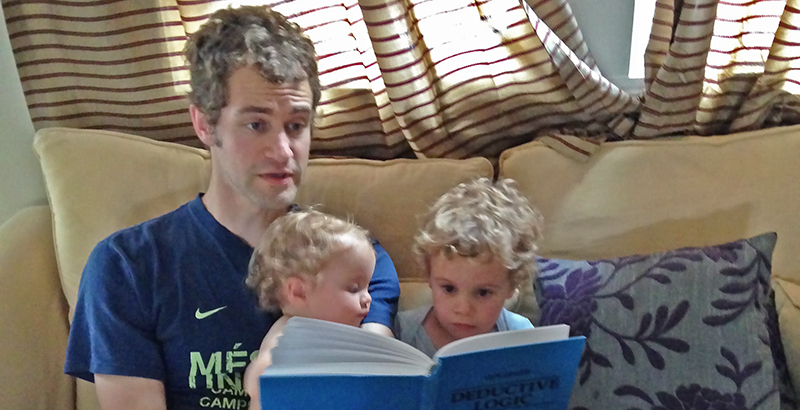Dad Talk: 8 Tips on Reading to Your Kids, a Comforting Constant in a Time of Parenting High Anxiety

It’s a tough time to be a parent. A movement has bizarrely arisen to question the value of vaccinating our children. We’re working more hours now than ever before — each of us setting up our own version of “Cat’s in the Cradle.” Academic scores appear to be largely flat.
What’s more, parents are bombarded with expert advice on how to “prepare kids for a 21st century economy” and “foster creativity in children.” The other day my kids and I came into a large quantity of cardboard boxes. No doubt about it — it was fort-building time.
And yet, I was paralyzed. Should I take the design lead and make something that was at once 1) cool and 2) safe? Should I let them trash the boxes (and the house)? How did something as basic as playing with your kids start to feel like something a dad can do “wrong?”
Yeah, it’s tough out there.
I’ve got some good news for you. After you feed, clothe, and shelter your kids, the next best thing you can do is read to them. And, better yet, it’s not like those boxes. Unless you’re opening up your toddlers to Infinite Jest, Being and Time, or presidential tweets, there’s almost no wrong way to do it.
Still, if you can’t shake the anxiety, I’ve got a few concrete tips to help you feel confident (as a former first-grade teacher who spent 2.5 years as his own children’s primary caretaker). They’re the core of what I did while teaching my kids to read. They might help you and yours as well.
But if they don’t, that’s no big deal — just make sure you read with them!
- Read all the time. I tried to read to my kids at least 30 minutes each day, but there’s no magic number. More is better than some, and some is better than none. Read fiction. Read nonfiction. Read poetry. Read the comics, the sports section, and/or travel guides.
- Read repetitively. When you find a book your kid likes, read it as many times as she’ll let you. It can wear on your sanity to run through The Lorax a dozen times a day, sure, but when you repeat a book, your kid starts to get comfortable with the language. Each time you run through it, she learns the rhymes, the plot, the vocabulary, and other nuances a little better. After you’ve read a book five or six times, try stopping short during key sentences and looking to see if your child knows the next word(s). This works especially well with books that rhyme.
- Go to the library. When you need a break from The Lorax, hit your local public library. Children’s literature, like many things in the United States, is increasingly stratified by wealth. Good books with rich pictures and text often cost a lot, and you don’t want to spend too much on outfitting your kids’ early reader library. The cost of a four-year public university degree is estimated to be over $200,000 by the 2030s. You can’t be spending all your money on signed, special-edition hardcover kids’ books.
- Goof around with voices. This is a must for some of the early children’s literature. Lots of board books are boring. But they’re also formulaic, which means that sometimes you can fit them to a song instead of just reading. As kids get older and books’ characters get more interesting, try making up voices for each one. I wasn’t good at figuring out voices, so I started picking random famous people to do—Bill Clinton, Christopher Walken, Jeff Bridges as The Dude, etc.
- Model sounding words out. It’s lame, but it seems to help. The cadence goes like this: “Hey, James, here’s a word. What’s that first sound? That’s right, it’s duh. Try that! Duh! And the next one is ahh. Let’s put them together. Duh-ahh. Last sound? Yes! Guh! Duh-ahh-G. Duh-ahh-g. Dog!” And speaking of sounding words out …
- Memorize books. Because I was reading the same books over and over, I memorized a few of them (especially One Fish, Two Fish, Red Fish, Blue Fish). Then I’d holler them to my kids while we drove around town, or while we walked back from the park, or whenever. Not kidding: I once recited One Fish, Two Fish to my son for a 45-minute drive back from Dulles Airport because it was the only way to get him to stop bawling.
- Make connections. Reading another book about dragons? Ask your kid if it reminds him of the last 10 dragon books you’ve read together. Reading books about dogs? Point out a dog while you’re walking around and ask him if it reminds him of any of the dog characters.
- Teach your kids the alphabet’s sounds, rather than its letters. Think about this for a second. My name is spelled C-O-N-O-R. Say the first letter’s name: “see.” But my name’s not pronounced “SEE-ONOR.” Kids who are learning to read need to recognize that letters represent sounds so that they can then combine those sounds into words. In their early schooling, the primary reason to teach them the names of the letters is so they can sing the Alphabet Song. Why don’t we teach them the sounds that letters make first … and teach them the names of letters later? Note: For vowels that make more than one sound, I taught my kids the “short” sounds. So they learned the letter “E” as the sound “eh.”
There you go. Try those out. They might help, and they certainly won’t hurt. Got more early reader tips? Come find me on Twitter @conorpwilliams.
Get stories like these delivered straight to your inbox. Sign up for The 74 Newsletter

;)
